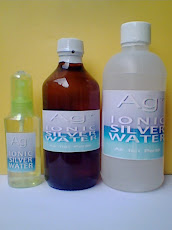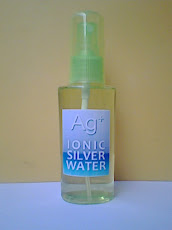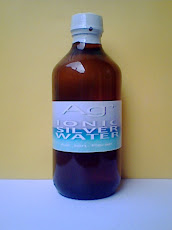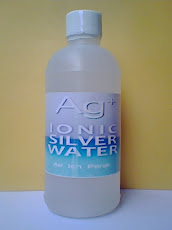Prior Civilizations In ancient times, the first metals discovered and used were gold, copper and silver, in that order. Among the ashes of fire pits used by Stone Age peoples are the remains of metallurgical work.
Discoverers associated the yellow color of gold with the sun. In turn, the white brightness of silver became associated with the moon. The Greek word argyros is derived from a Sanskrit root mean shining white. In Latin, the moon is known as luna. The surgical cauterizer made from silver nitrate and niter is still known as lunar caustic today. The later Latin name argentum comes from an Aryan root meaning white and shining. The word silver is of Gothic origin meaning shiny white. The optical properties of silver are distinctive because of its exceptionally high reflectivity and very low emissivity.
For thousands of years, silver has been highly regarded as a versatile healing tool. In ancient
Hippocrates, the "Father of Medicine," taught that silver healed wounds and controlled disease. Around 400 B.C., he listed as a singular treatment for ulcers "the flowers of silver alone, in the finest powder."
Herodotus describes how the King of Persia carried with him boiled water in silver flagons to prevent sickness.
In 69 B.C., silver nitrate was described in the contemporary Roman pharmacopoeia.
Pliny the Elder, in his survey of the world's knowledge, Natural History (78 A.D.), states in Book XXXIII, Section XXXV, that the slag of silver "... has healing properties as an ingredient in plasters, being extremely effective in causing wounds to close up..."
The popularity of medicinal silver especially arose from 702 A.D. through 980 A.D. throughout the
Paracelsus (circa 1520) extensively incorporated silver medicinally, and later Caradanus, Pareus and Sala also used it.
Angelus Sala used silver nitrate to successfully treat chorea, tabes dorsalis (syphilis), and "doubtably epilepsy". These crude forms of silver were reported by Sala to rarely cause the bluish hue of skin discoloration due to its overuse (Argyria).
It is widely thought that during the Middle Ages, silver utensils and goblets contributed a bluish hue to the skin tone of the upper class, resulting in the term "royal blue bloods." Plausibly the term "born with a silver spoon in his mouth" was coined during that time for the same reason, as an attribute for describing the good fortune of health more than having wealth. These blue bloods were noted to have obtained a measure of protection from the rampant plagues common to
Today it is known that metallic silver will dissolve in water to the level of 10-5 g/l, which is toxic to Escherichia coli and Bacillus typhosus.
Pioneers of the American West would often put a silver dollar into a jar or container of milk to help keep it fresh without refrigeration. They would also drop silver and copper coins in their barrels of drinking water to combat bacteria and algae.
During the wars with Napoleon, the armies of Tsar Alexander used water casks lined with silver to clean drinking water from rivers and streams. This practice by the Imperial Russian army was common through World War I and continued to be incorporated by some units in the Soviet Army during World War II.
Raulin recorded the first clinical description of the water-cleansing effect by silver in 1869. He observed that Aspergillus
Modern Research using the Scientific Method In 1861, Thomas Graham found that certain solutions would pass through a membrane and others would not.
He found a stable, intermediate state of matter and was able to describe it. Graham discovered that substances could enter a solution in such a manner that they would exhibit characteristics quite different from those of a true solution. He applied the term "colloidal" (from kolla = glue) to this intermediate state, since glue, gelatin, and related substances were the most obvious to him as being in this unique state.
The Swiss botanist von Nageli recorded one of the amazing discoveries of the 19th Century in 1869. Von Nageli coined the term "oligodynamic" to describe the microbiocidal properties of a metal hydrosol (e.g. copper, silver and tin) at minute concentrations.
Silver is unique in its action against micro-organisms.
Recent studies confirm that silver ions are active against bacteria at concentrations as low as one part per billion in pure water. Silver ions react rapidly with the walls of prokaryotic cells typical of micro -organisms, whereas the membranes of eukaryotic cells of mammals strongly resist any effect by silver.
In 1884, the German obstetrician C.S.F. Crede, observed that there was a 79% relationship between blind children and maternal venereal disease. He subsequently introduced a prophylactic l% silver nitrate eye solution for newborns for the prevention of ophthalmia neonatorum. Following its introduction, the incidence of eye disease in newborns dropped to about 0.2%. His treatment was a milestone in clinical prophylaxis and became a government regulation throughout most of the world. By 1897, silver nitrate began to be used in
By 1910, Henry Crookes had documented that certain metals, when in a colloidal state, had strong germicidal action, but were harmless to human beings. The oligodynamic concept motivated the development of many antimicrobial processes and products.
One of the water purification developments that took place in 1928 was the development of Katadyn silver, described as a porous metallic, spongy mesh that attempts to maximize surface area. This silver meshwork also contains a small quantity of gold or palladium. Katadyn silver has been used inside flasks and storage containers and with water filters.
Both the
Many urologic implements were made of silver and commonly used during the period of 1930 to 1960.
This author has a Keyes-Ultzman silver urethral canula designed to reach the prostatic urethra. The advent of inexpensive stainless steel and improved sterilization methods greatly diminished the clinical market for silver implements.
During World War II, Charles L. Fox, a surgeon, observed that many soldiers died of uncontrolled bacterial infection in open wounds. He had long used silver nitrate as part of his medical practice, but it was far too aggressive with protein structures - limiting its clinical uses. His research at the Department of Surgery and Microbiology,
It is a dual antagonist: silver has the primary activity against pathogens but should an organism be sensitive to sulfonamids, the sulfadiazine component will also be active. This dual function has been extensively studied to show effectiveness against a wide range of bacteria, fungi, extra-cellular viruses and protozoa.
During the last century, advances in pharmacological manufacturing methods sought to harness this time-valued strategy expressed in nearly all silver formulations. Yet early manufacturing methods rarely created high quality, homogeneous oligodynamic silver.
Nevertheless, more than 96 different silver medicinals (many used intravenously) were in use prior to 1939, as documented by the Council on Pharmacy and Chemistry of the American Medical Association.
introduction of Argyrol, a silver-protein compound that provided silver ions for minor illnesses, was one of the most successful silver-based preparations. Argyrol was widely marketed until the advent of the miracle drugs during the 1950's.
Also during the 1950's, Czech researchers developed a gennicidal silver product called "Movidyn".
It was initially popular because it was much less expensive than chlorine-based disinfectants. Studies of contaminated wells found that Movidyn completely eliminated anaerobic bacteria such as Vibrio cholerae, which causes cholera, and aerobic bacteria such as Escherichia coli, a potential enteric pathogen and the most common organism associated with "traveler's diarrhea", and the Rickettsial pathogens associated with typhus, and protozoa such as Entamoeba histolytica associated with amebiasis. Apparently the Soviet military had the Czech manufacturing facility disassembled and shipped to
Charles E. Renn at the Department of Sanitary Engineering and Water Resources, Johns Hopkins University conducted studies in the 1950's that revealed drinking water could be disinfected if very fine silver particles were deposited in an activated carbon. The resulting filter acted as a mild galvanic couple or battery that caused silver to dissolve. Silver concentrations varied 25 to 40 parts per billion. The activated carbon adsorbed undesirable organic compounds including cancer-inducing trihalomethanes that can be generated in the presence of chlorine.
Silver impregnated activated carbon is a major component of the $4,000,000,000.00
Research conducted at the Department of Microbiology and Immunology,
Silver and copper ions penetrate biofilms that build up in hospital plumbing, destroying entrenched Legionella and other pathogenic organisms. The stability of silver and copper ions provides long-term margins of safety. In addition, these ions drift into and sanitize the less-used portions of the water supply system. Over 100 hospitals in the
conducted over decades at the College of Physicians and Surgeons, Columbia University revealed that the minimum bactericidal concentration of silver required for biocidal activity against bacteria in pure water was 0.5 and 0.1 um/ml or 0.1 ppb.
A project begun in the early 1970's by Robert Becker, an orthopedic surgeon, involved a silver nylon product. This project was instigated in order to find an electromagnetic shield. Instead, it lead to the revolutionary discoveries by Becker of silver's unique properties to increase the rate of tissue regeneration in diseased or damaged tissues and his discovery that silver ions could induce fibrocytes to dedifferentiate into stem cells and back again.
Becker also addressed the fact that children under 4 years of age could regenerate fingertips with silver.
His extensive studies suggest that the regeneration effect initiated by silver appears to be similar to that seen in salamanders, which regenerate lost parts.
While at the
Electrically driven silver ions were found to consistently penetrate one centimeter within 20 minutes into local proteins at a wound site and were effective in treating osteomyelitis, similar infectious diseases, and the silver proved to be a stimulus for reconstruction of tissue in large wounds.
Decades of practical application revealed that this technique was effective against both gram-negative and gram-positive bacteria. No bacteria proved resistant to the silver ions or developed a resistance to silver after treatment. Toxic effects to this process were negligible. During electrically driven silver ion treatment, a profuse exudate composed of large numbers of cells formed at the wound site. This exudate was accompanied by a dramatic increase in the rate of wound healing. No other known technique is capable of producing this effect.
One of Becker's research associates, A. Bart Flick, continued work in this area for professional and commercial applications. As a result, Flick has filed patents in 1994, 1996 and 2000 for silver-based wound dressings that are far superior to anything that has ever been available before. He has also obtained approval for these wound-dressing products from the
45 Food and Drug Administration."" Because of the success of these silver dressings, many other medical product manufacturers have filed for their own parallel products. Silver products include many variations of bandages, intratracheal tubes and catheters.
A 12 month randomized, multi-center trial study of uncoated and silver-coated urinary catheters was conducted in wards at the University of Medicine, Baltimore, the University of Virginia Health System, Charlottesville and the University of Pittsburgh Hospital, Pittsburgh. This trial revealed that the risk of infection declined by 32% among patients in whom silver coated catheters were used. The silver subset of patients also had a decreased length of hospital stay and a decrease in morbidity. The estimated savings in hospital cost was nearly $500,000.
In the early 1970's treatment of severe burn cases using silver topical salves, such as silver sulfadiazine, provided superior control and prophylaxis. Today, multiple drug resistant (MDR) microbes are challenging this formulation's effectiveness, but this review shall discuss how state-of-the-art silver protocols and formulations offer superior protection against microbial strategies for acquiring resistance.
Absolute microbial resistance to medicinal silver has not been scientifically established.
Several studies have indicated that some bacterial species have physiological mechanisms that circumnavigate silver's toxicity. Although it is clear that some pathogens have mechanisms to survive exposure to certain forms of silver, these mechanisms are limited when compared to higher life forms. Herein lie all the clues necessary to identify strategic silver therapeusis that pathogens are unlikely to survive.
It is probable that pathogens lack sufficient defense mechanisms to circumvent the toxic effects of silver ions when oligodynamic silver is delivered in sufficient, physiologically compatible quantities.
In fact, the "apparent" resistance of microbes to silver was mistakenly noted by many who failed to notice and identify:
(a) insufficient oligodynamic silver particle concentrations, (b) ineffective percentages of charged particles, (c) inadequate protocols (d) improper procedures.
Reports that multiple-drug-resistant (MDR) pathogens (i.e., MRSA ( and Acinetobacter spp.) were truly resistant to silver proved to be erroneous. Grier stated, "Some so-called silver-resistant micro-organisms may result from an apparent neutralization of the metal's inhibitory action or other assay artifacts. These include the presence of chelators such as serial amino acids, constituents of hard water, different buffers, light, incubation temperature, and particularly, soluble components of trypticase soy agar (TSA) and tryptose glucose extract agar (TGE).
Currently, bacterial pathogens are unable to cope with sustained exposure to a silver hydrosol.
With the advent of antibiotic therapy, medicinal silver products fell largely into disuse (circa 1940 -1945), with the notable exceptions of topical silver salves and neonatal eye drop preparations.
These salves advanced the science of "silver salt-derived" delivery and effectiveness in the mid 1960's. Then, during the mid 1970's, several papers were published that utilized electrically activated silver probes as delivery systems for targeted oligodynamic.
More information is available from the U.S. FDA on Silverlon or the company that manufactures this dressing product. silver strategies. 81 The interest in such strategies continues to grow to the present, with high efficacy being obtained for viral vectors such as HIV 82 and resistant bone and dental infection. 83
Sufficient defense capacity to mitigate morbidity clearly exists in higher organisms, including humans (with the exception of medically benign Argyria).g4 Zhao and Stevens state that, "With the rise of antibiotic-resistant bacteria, silver is re-emerging as a modern medicine because all pathogenic organisms have failed to develop an immunity to it (Ag+)."
Silver is being used in the
For example, silver dihydrogen citrate, Axenohl° is an electrolytically generated compound that works well with other compounds used as hard surface disinfectants for food contact surfaces, clinical work surfaces, medical disinfectant wipes, and water treatment systems. The black polyvalent silver oxide [Ag404] is a compound unit with two single-charged and two triple¬charged silver atoms. It is a microcidal compound effective against bacteria, yeast and mold.
It is a safe, EPA approved antiseptic oxide compound.
Tetrasil° is an example of this oxide used in a bactericidal topical ointment. It is also the best choice of relatively inexpensive silver currently available for sanitizing acrylic hot tubs.
Research initiated in the 1990's by the Chinese government through the Department of Materials Science and Engineering,
This silver complex also maintained perfect safety with no toxicity to humans. The Science & Technology Ministry of China certified the new antimicrobial as a "National Key New Product". It is marketed as Concal PAg-40TM.
In Vitro Studies The medical literature of the early 20th century regarding silver provides an important cautionary lesson from the past. Previous scientists, who were either supporters or detractors of silver medicinals, typically expressed equivocal knowledge and misapplied context because they failed to recognize silver speciation. This fault undermined their definitive knowledge about silver.
Correct and in-context discernment of silver's therapeutic threshold remains elusive to most investigators even today. This "box" perception about silver will continue to lose its limitations as technology continues to prove itself outside of that box in the coming decades.
Clinical reports on silver medicinals began to flood into the various medical journals worldwide at the start of the last century.
Initially, the Journal of the American Medical Association took a negative position.
But within 11 years, a true revolution in medical practice with silver medicinals occurred that did not subside until the
Throughout this period, 1920 through 1942, JAMA articles were replete with oral (per os) and intravenous clinical reports of the efficacy and side effects of silver medicinals.
I

.jpg)



Tidak ada komentar:
Posting Komentar